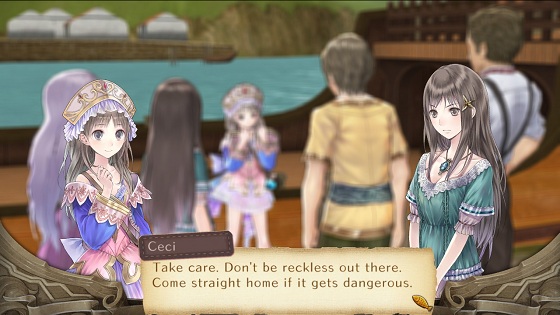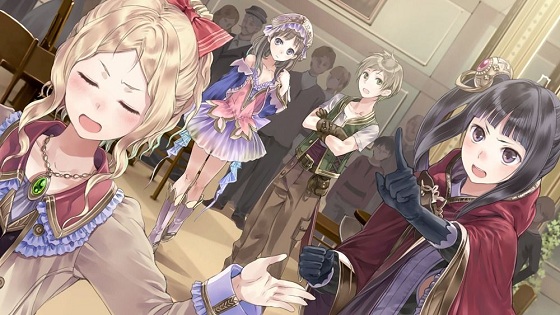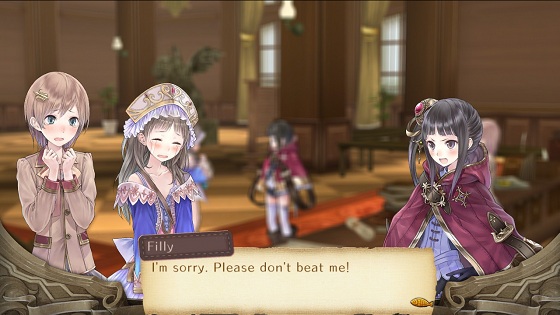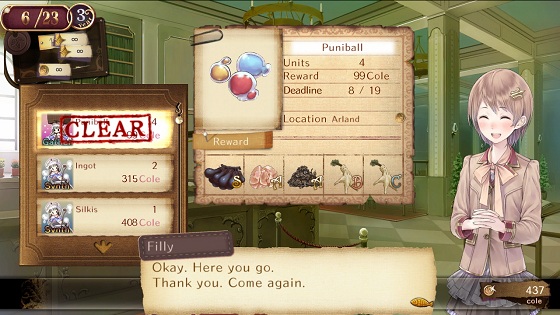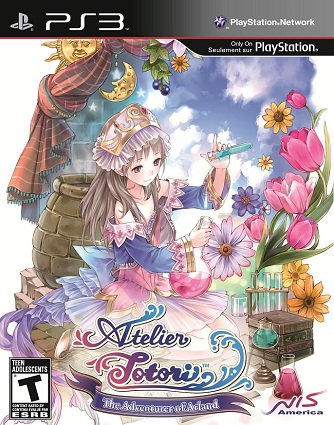
Atelier Totori: The Adventurer of Arland
Developer: Gust
Publisher: NIS America
Platform: PlayStation 3 (Reviewed)
Release Date: September 27, 2011
Price: $49.99 Standard, $59.99 Premium
Overview:
RPGs as a genre have evolved much over the years. There are titles which have evolved so much that they cannot even be called RPGs anymore, and then there are also those who have stuck true to the heart of what an RPG game was years ago. Usually the most unmoving formula for an RPG is that of the Japanese RPG or JRPG.
Now while these titles usually do not evolve much past their genre, there are those which take what an RPG is and make it their own. This is what has been done with Atelier series. Being the sequel to last year’s Atelier Rorona; Atelier Totori: The Adventurer of Arland has a tough predecessor to follow but in doing so, creates a wonderful and lighthearted journey rarely found in today’s gaming world.
Story:
Five years have passed since Rorona’s adventures in the Atelier Rorona and in this time Rorona has made quite a name for herself, even taking up a student of her very own. Players take the role of young thirteen year old Totooria Helmond, the daughter of a famous adventurer. Called Totori by everyone she knows, she readily accepts to train under Rorona and become the best adventurer in the world.
Her reasoning for becoming an adventurer is twofold. Not only does she want to follow in her famous mother, Gisela’s, footsteps but also track her down after she went missing many years before on a journey. While the rest of her town and even her own family believe the worst has happened, Totori resolves to find her mother and become the best adventurer the world has ever seen. Of course the first step to becoming an adventurer is to acquire an adventurer’s license from the government, which places Totori on the road of adventure and even discovery.
When the genre RPG comes to mind, the first thing most gamers will immediately think of the standard trope where the world is about to be destroyed, a war is about to break out or some other catastrophe that must be adverted and for some strange reason your commoner of a characters is the only one who can stand against the darkness and protect the world of light. There is none of that here in Atelier Totori.
Perhaps one of the biggest positives about the game’s storyline is the fact that it is very light hearted and has to deal with the emotions of the characters and the journey that Totori must make to find her mother. Now this may not be a huge development at the surface, Totori’s personality is what helps make this adventure shine. She is much more reserved and shy than Rorona was in the past game, and seeing her grow as a person as well as persevere through difficult situations and succeed, knowing you were there controlling the experience made it all the better.
Now while Totori shines as the heroine of the story, the side characters which join you along the way help flesh out the cast with more personality and humor. There are brand new characters such as your childhood friend Gino, an overly strong veteran adventurer Mel, tsundere-like aristocrat Mimi and a very whacky inventor who calls insists he is given a long list of titles named Marc. That isn’t to say that a few cast members don’t show back up to join Totori from the past game such as Sterk. All of these characters have their own unique personalities and bringing them along with you on your adventures will always lead to side interactions as you journey from place to place, making it hard to not like the cast of characters.
Now an interesting thing was done with Totori’s story, they have made it a much more open storyline. There really isn’t a strict plot path that must be taken, though there is a specific deadline that has to be reached after a certain point. Totori’s main way of progressing through the storyline is simply passing time. Players are given three years to venture the world of Arland and upgrade their adventurer’s license which is done through a number of tasks.
These tasks can best be seen as side missions which range from synthesizing and creating items, traveling to locations, fighting bosses, fighting a certain amount of enemies or gathering certain ingredients. In the end this creates a very unique experience that allows a player to tackle the game with a certain amount of freedom in what they want to do. When a certain amount of adventurer points are acquired, the player can level up their license and unlock more difficult missions as well as more areas to explore and gather materials from.
All in all, there is a definitive ending and certain tasks have to be performed to get the best ending, but there are a number of other endings which can be obtained, including a New Game+ which allows for a much more enjoyable experience.
Graphics:
Making a beautiful looking game can be quite difficult, but Gust has begun to make it look like something they are used to on a daily basis. This of course means that Atelier Totori looks absolutely amazing. The character models in the 3D worlds look absolutely stunning and are detailed with intricate designs and outfits, making combat extremely pleasing to the eye. Exploration and gathering areas are amazing to see and well varied in appearance with most areas matching what you would expect to find there, such as nuts and weeds in a forest and rocks and shells by a beach.
That is nothing however on the artwork whenever players are in a conversation with a character or watching storyline unfold. The artwork for each character is breathtaking and beautiful in both design and coloration. Not only are these impressive, but whenever something special occurs in the story a full-screen artwork is displayed on the screen only driving home the fact that the game’s artwork is absolutely gorgeous.
Audio:
There are a few things that are wrong with Atelier Totori when it comes to what you will be hearing, but the background music is not one of them. All of the music is quite lighthearted and pleasant, usually played with a flute and string instruments. The main theme that players will be greeted to every time they start up the game is very enjoyable and the battle themes fit adequately enough. One complaint however is that while a lot of the soundtrack is fresh and new a few tracks are recycled from Atelier Rorona which is disappointing for those hoping for an entirely fresh audio experience.
Unfortunately the main problem here is the fact that the voice acting is hit and miss at best. Returning characters from Rorona keep the same voice actors which is a plus and Totori’s voice actress matches her personality well. Her meek voice and personality are quite charming and help push her to be an enjoyable main character. On the other hand the newer character’s voice actors sound like they are simply phoning in their roles or simply will be irritating after a short period.
The plus side here is that, since character development and interaction is usually focused on who you bring with you on adventures, you can ignore characters whose voice acting gets on your nerves. Still, NIS America included the Japanese voices for the game if players wish to use that instead, but then they would miss out on Totori’s quality voice work.
Gameplay:
Atelier Totori follows its predecessor quite closely by retaining much of what made Atelier Rorona great and improving on various aspects of it. This has helped streamline the experience and make the title very accessible. One of these neat improvements is the way that players can instant travel between areas in a town. For example, you can be making something in your workshop and need to travel to the bar to turn in items for a mission. Rather than walk to the bar you can simply quick travel right there which makes things move at a brisker pace in towns.
One of the most interesting parts of Totori that is close to Rorona is the alchemy system. The title contains the same easy to understand and manage system that players experienced in past titles. Items you gather from enemies, gather points in the field or buy off of stores all have a certain quality ranking to them from S being the best to E being the worst. When you combine these items into a recipe you can then choose from a number of traits that were on the ingredients you used to create the item and can help improve the quality or effectiveness of an item which is essential to those used in combat.
That being said, items that you carry with you for a long period of time can degrade and become less effective, meaning that it isn’t always recommended to carry strong healing items always with you in bulk, or the next time you are in a pinch that healing salve may do only half of what you expect it to do. This is managed through a rather easy to use inventory management system. Whenever you return back to your workshop you will be automatically asked if they want to deposit ingredients to their container in the workshop. This container holds 999 items and items inside of the container do not degrade and can be easily sorted through with a search system. Given the player’s limited basket carrying ability of 60 items, this easy to use container management makes item gathering and keeping a breeze.
Now there is also a certain amount of fighting that will be had in Atelier Totori outside of alchemy and item management. These battles can sometimes be quite important to gaining points to your adventurer’s license so it is a must to quickly become accustomed to the mechanics. Atelier Totori uses the time tested method of turn based fighting, with enemies and allies attacking at preset intervals shown on the screen. Players will have each have their own health amount and MP amount, but the only people on the team which can use items are Totori and Rorona so it is a must to keep these two protected.
That is where the assist system comes in. Whenever one of your other party members attacks, a bar underneath of their stats will fill up. Once the bar is a quarter full, you can trigger them to jump in front of an attack to protect Totori or even to follow up on an item throw to deal extra damage when their turn isn’t even up yet. This helps provide a real sense that the party is fighting together and working towards the win opposed to the standard system where everyone fights on their own.
Overall:
Atelier Totori: The Adventurer of Arland outdoes its predecessor ably in everything that you could look for. Gust has outdone itself with this release and NIS America performed an outstanding job localizing the title for North American release. Although there are a few issues with the voice cast, Totori herself is more than enough to make up for it.
As a whole, Atelier Totori epitomizes the saying it’s the journey, not the destination. The storyline for Atelier Totori may not be something that everyone would like as there is really no overarching dilemma pushing the player forward. Rather the driving force is to see how well the characters interact with one another and how Totori grows from being a shy girl who grew up in the countryside to an able adventurer willing to take on any job and along the way perhaps find out the truth about her mother. Atelier Totori is a rare game in this day and age and one that should not be missed.
I give Atelier Totori: The Adventurer of Arland



